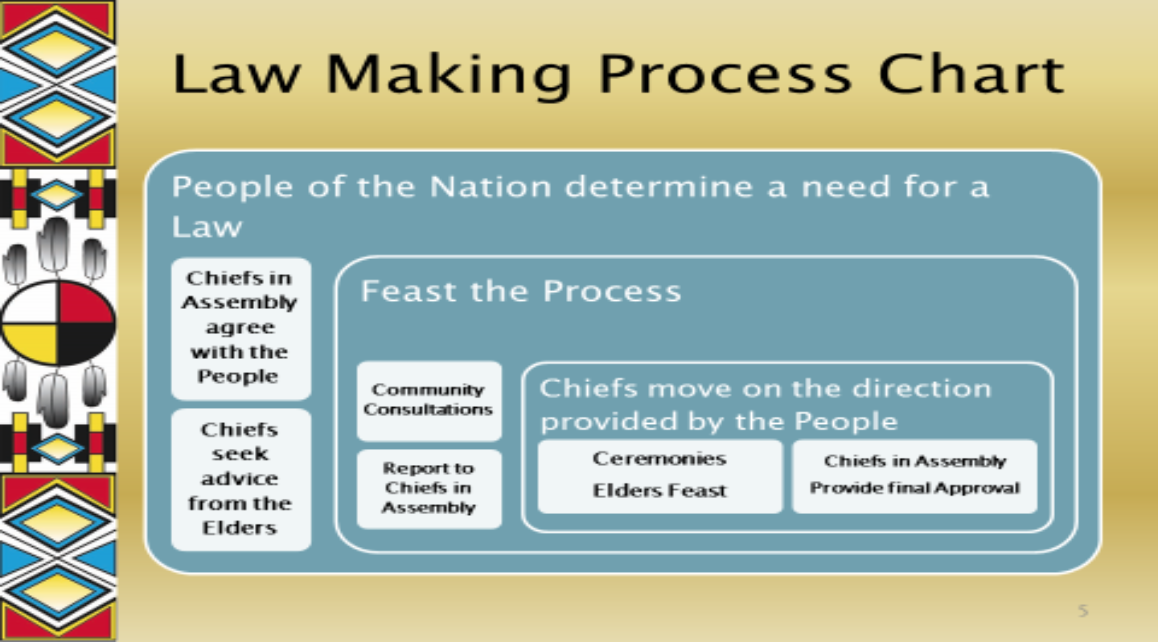Anishinaabe Abinoojii Inakonigewin – Treaty #3 Child Care Law
Anishinaabe Inakonigewin was declared and adopted in October 2005
The Child Care Law or Anishinaabe Abinoojii Inakonigewin, has its roots in the sacred law of our people. Sacred Law comes from Giizhi Manido/Creator. Sacred Law is founded in spirituality and spiritual gifts – minigoosiwin; and with these gifts comes duties, roles, and responsibilities. The Sacred Law of the Anishinaabe people is understood as such: The child is a sacred gift from Manido and this child represents the continuity of the Nation (Anishinaabe).
The concepts that guide Anishinaabe Abinoojii Inakonigewin come from Traditional Anishinaabe Law which is universal and is forever.
“Traditional Anishinaabe Law recognizes that the child must live, belong and grow within an environment of human relationships rooted in the family, the clan and the community, and that these needs are essential to the best interest of every Anishinaabe child; and Anishinaabe culture comprises the whole accumulated knowledge and wisdom that has enabled the people to survive and live a good life: and, Traditional Anishinaabe Law requires each Anishinaabe person to protect and uphold the culture for the benefit of future generations, and gives the Anishinaabe people guidance for their lives.” (The Anishinaabe Nation of Treaty #3, Child Care Law, 2005)
Customary Law can be compared to temporal law; it can be codified and can change over time.
“The Anishinaabe people has since time immemorial passed down to successive generations, and adapted for each generation, temporal law consistent with traditional law to meet the needs of successive generations as they may arise, including law for the care and protection of its children and families” (The Anishinaabe Nation of Treaty #3, Child Care Law, 2005).
“The nation now finds it necessary for the care of its children and protection of its families to express certain aspects of its temporal law in writing so that it may be better and more widely understood and respected, and to adapt it to meet the needs of the present generation” (The Anishinaabe Nation of Treaty #3, Child Care Law, 2005)
The Lawmaking process of the Treaty #3 Anishinaabe
- Started with Ceremony
- Consultation with Elders to ensure cultural permissibility
- Consultation with the Nation: women, men, youth, children, helpers (social/health service agents)
- Drafting of the Law
- Consultation with leadership and nation
- Back to Ceremony: ensuring nothing was in document that would harm the people
- Final Draft brought to “National Assembly” (not Chiefs in Assembly), a meeting of the people of the Nation
- Consult with Grand Council of Elders
- Enactment of Law
- Adopted as National Law 2005

Nation’s Responsibilities for Anishinaabe Abinoojii Inakonigewin
- Ka Niigaanibowe’t for the Nation (Equivalent to the Minister)
- Ka Niigaanibowe’t recognizes Directors of the Agencies (Weechi-it-te-win and Anishinaabe Abinoojii Family Services)
- National agencies (WFS and AAFS) report to the Ka Niigaanibowe’t at the National Assembly and as required on the state of Child Care in the Nation.
Responsibilities of the Nation
- To enact the Law
- To educate the people about the Law
- Develop a process of application of Law
- Negotiate the Harmonization of the Law-Exemptions as Alternative Measure/Process
- Consulting with the Elders on the Guiding Principles of the Law- For Child Care and the Family – Abinoojii Omibig Igos Owin
- Establishment of Working Group-TOR
- Work with Communities Ready to Adopt the Law/-Wabaseemoong and Onigaming. To Date Wabaseemoong and Onigaming have declared that their
- communities will be implementing Anishinaabe Abinoojii Inakonigewin
- Seek support for capacity development work
- Meetings with the Ministers-MCYS/MAA
- Community Assent-must signify consent to the Law-Respects tribal independence
- Development of Community Codes and Standards-Takes National Law further
- Adjudication System-Clan System-Non-voluntary cases-legal principles in the language-more meaningful
- Serve Notice to Grand Council-Work is complete
- Community Code/Law-Unique to each First Nation, i.e., Amnesty vs. Expulsion, Community Standards for Alternative Care Homes, custom adoption, abuse
- Own Standards of Care
- Community develops infrastructure for the operation of services-Community Boards
Responsibilities of Agencies of National Interest
Weechi-it-te-win Family Services and Anishinaabe Abinoojii Family Services
- To educate the First Nations on the National Law-Abinoojii Inakonigewin
- To assist the First Nations in developing their Community Codes-complementary to not in violation of National Law
- Monitors and oversees that community code is being adhered to
- Coordinating Function
- Ministerial Function
- Line up to empower the Leadership
